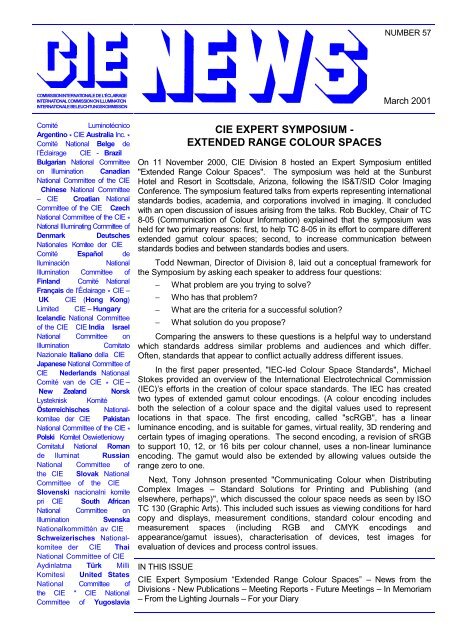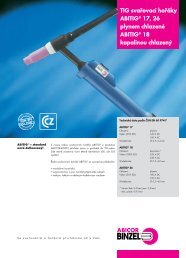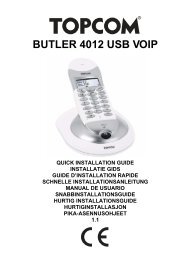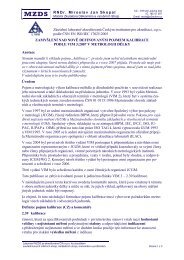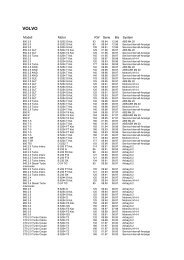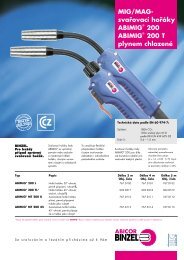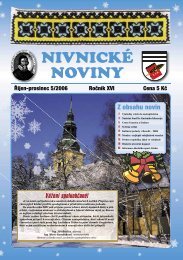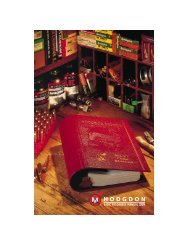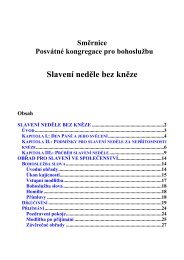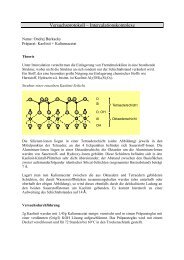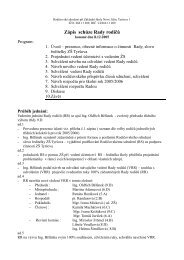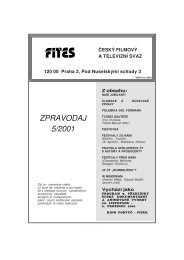Central Bureau: Kegelgasse 27 A - 1030 Wien, Austria - Web
Central Bureau: Kegelgasse 27 A - 1030 Wien, Austria - Web
Central Bureau: Kegelgasse 27 A - 1030 Wien, Austria - Web
Create successful ePaper yourself
Turn your PDF publications into a flip-book with our unique Google optimized e-Paper software.
COMMISSION INTERNATIONALE DE L’ÉCLAIRAGE<br />
INTERNATIONAL COMMISSION ON ILLUMINATION<br />
INTERNATIONALE BELEUCHTUNGSKOMMISSION<br />
Comité Luminotécnico<br />
Argentino * CIE Australia Inc. *<br />
Comité National Belge de<br />
l’Éclairage CIE - Brazil<br />
Bulgarian National Committee<br />
on Illumination Canadian<br />
National Committee of the CIE<br />
Chinese National Committee<br />
– CIE Croatian National<br />
Committee of the CIE Czech<br />
National Committee of the CIE *<br />
National Illuminating Committee of<br />
Denmark Deutsches<br />
Nationales Komitee der CIE<br />
Comité Español de<br />
Iluminación National<br />
Illumination Committee of<br />
Finland Comité National<br />
Français de l’Éclairage * CIE –<br />
UK CIE (Hong Kong)<br />
Limited CIE – Hungary<br />
Icelandic National Committee<br />
of the CIE CIE India Israel<br />
National Committee on<br />
Illumination Comitato<br />
Nazionale Italiano della CIE<br />
Japanese National Committee of<br />
CIE Nederlands Nationaal<br />
Comité van de CIE * CIE –<br />
New Zealand Norsk<br />
Lysteknisk Komité<br />
Österreichisches Nationalkomitee<br />
der CIE Pakistan<br />
National Committee of the CIE *<br />
Polski Komitet Oswietleniowy<br />
Comitatul National Roman<br />
de Iluminat Russian<br />
National Committee of<br />
the CIE Slovak National<br />
Committee of the CIE<br />
Slovenski nacionalni komite<br />
pri CIE South African<br />
National Committee on<br />
Illumination Svenska<br />
Nationalkommittén av CIE<br />
Schweizerisches Nationalkomitee<br />
der CIE Thai<br />
National Committee of CIE<br />
Aydinlatma Türk Milli<br />
Komitesi United States<br />
National Committee of<br />
the CIE * CIE National<br />
Committee of Yugoslavia<br />
CIE EXPERT SYMPOSIUM -<br />
EXTENDED RANGE COLOUR SPACES<br />
NUMBER 57<br />
March 2001<br />
On 11 November 2000, CIE Division 8 hosted an Expert Symposium entitled<br />
"Extended Range Colour Spaces". The symposium was held at the Sunburst<br />
Hotel and Resort in Scottsdale, Arizona, following the IS&T/SID Color Imaging<br />
Conference. The symposium featured talks from experts representing international<br />
standards bodies, academia, and corporations involved in imaging. It concluded<br />
with an open discussion of issues arising from the talks. Rob Buckley, Chair of TC<br />
8-05 (Communication of Colour Information) explained that the symposium was<br />
held for two primary reasons: first, to help TC 8-05 in its effort to compare different<br />
extended gamut colour spaces; second, to increase communication between<br />
standards bodies and between standards bodies and users.<br />
Todd Newman, Director of Division 8, laid out a conceptual framework for<br />
the Symposium by asking each speaker to address four questions:<br />
− What problem are you trying to solve?<br />
− Who has that problem?<br />
− What are the criteria for a successful solution?<br />
− What solution do you propose?<br />
Comparing the answers to these questions is a helpful way to understand<br />
which standards address similar problems and audiences and which differ.<br />
Often, standards that appear to conflict actually address different issues.<br />
In the first paper presented, "IEC-led Colour Space Standards", Michael<br />
Stokes provided an overview of the International Electrotechnical Commission<br />
(IEC)’s efforts in the creation of colour space standards. The IEC has created<br />
two types of extended gamut colour encodings. (A colour encoding includes<br />
both the selection of a colour space and the digital values used to represent<br />
locations in that space. The first encoding, called "scRGB", has a linear<br />
luminance encoding, and is suitable for games, virtual reality, 3D rendering and<br />
certain types of imaging operations. The second encoding, a revision of sRGB<br />
to support 10, 12, or 16 bits per colour channel, uses a non-linear luminance<br />
encoding. The gamut would also be extended by allowing values outside the<br />
range zero to one.<br />
Next, Tony Johnson presented "Communicating Colour when Distributing<br />
Complex Images – Standard Solutions for Printing and Publishing (and<br />
elsewhere, perhaps)", which discussed the colour space needs as seen by ISO<br />
TC 130 (Graphic Arts). This included such issues as viewing conditions for hard<br />
copy and displays, measurement conditions, standard colour encoding and<br />
measurement spaces (including RGB and CMYK encodings and<br />
appearance/gamut issues), characterisation of devices, test images for<br />
evaluation of devices and process control issues.<br />
IN THIS ISSUE<br />
CIE Expert Symposium “Extended Range Colour Spaces” – News from the<br />
Divisions - New Publications – Meeting Reports - Future Meetings – In Memoriam<br />
– From the Lighting Journals – For your Diary
Jack Holm of ISO TC 42 (Photography) presented a<br />
paper, "Extended Colour Encoding Requirements for<br />
Photographic Applications" co-authored with Ken<br />
Parulski and Eric Edwards. TC 42 has begun work to<br />
define extended colour encodings for storage,<br />
manipulation, and interchange of digital still pictures.<br />
TC 42 has delineated two classes of extended colour<br />
encodings, input-referred and output-referred. Inputreferred<br />
colour encodings are needed to encode<br />
scenes in terms of their colorimetry and the associated<br />
data needed by colour appearance or reproduction<br />
models. Output-referred colour encodings represent the<br />
colorimetry of images that have been colour rendered<br />
for specific output conditions.<br />
Hiroaki Ikegami offered a different perspective in his<br />
talk, "Colour Space Selection for Colour Facsimile<br />
Standardization in ITU-SG8". He described how<br />
CIELAB came to be chosen as the standard colour<br />
encoding for colour facsimile. The methods used would<br />
also be useful in the selection of colour encodings for<br />
colour management systems.<br />
The colour gamut reproduced by film is much<br />
larger that the colour gamut that can be reproduced<br />
by present day television. In "Extended Range Color<br />
Space Studies for Digital Cinema", Fred Van Roessel<br />
described how the Society of Motion Picture and<br />
Television Engineers (SMPTE) DC 28 Ad Hoc Group<br />
on Colorimetry developed a standard encoding for<br />
digital cinema. The requirement to match film or<br />
improve on film led to select a set of colorimetric<br />
primaries, outside the spectrum locus, that allow the<br />
reproduction of all possible colours. A logarithmic<br />
signal representation was chosen for the red, green<br />
and blue signals to accommodate a larger dynamic<br />
luminance range.<br />
In "Standards Activities for the Colour<br />
Management of Colour Printers", Fumio Nakaya<br />
presented the work being done in the IEC toward the<br />
standardization of printer colour management. This<br />
involved issues such as standard illumination<br />
conditions, evaluations of preferred colour<br />
reproduction, gamut mapping based on marking<br />
technology, and standard colour targets.<br />
Most of the talks in the Symposium focused on<br />
RGB colour spaces. Prof. Ikegami's talk on CIELAB<br />
was one exception. The other was Prof. Ronnier Luo<br />
and S. Y. Zhu's paper on "Testing the uniformity of<br />
colour spaces". A uniform colour space (UCS)<br />
provides that equal distances approximately<br />
represent equal perceived colour differences. Luo<br />
argued that a UCS is an ideal colour space for colour<br />
communication, gamut mapping, and imaging<br />
compression, because uniformity is vital for these<br />
applications. The talk compared several UCSs:<br />
CIELAB, OSA, ATD, Kuehni, CIECAM97s and colour<br />
difference formulae such as GLAB, CIE94, CMC,<br />
CIELAB2000.<br />
2 – CIE NEWS 57<br />
One of the industrial representatives, Kevin<br />
Spaulding, presented the final paper "Image States and<br />
Standard Extended Color Gamut Color Encodings".<br />
He presented two colour encodings developed by<br />
Kodak: RIMM RGB and ROMM RGB. RIMM is an<br />
input-referred encoding; ROMM is output referred.<br />
ROMM RGB has been submitted to PIMA<br />
(Photographic and Imaging Manufacturers Association)<br />
for consideration as a standard.<br />
The meeting concluded with an open discussion<br />
between the speakers and other conference attendees.<br />
This gave people a chance to clarify points that had<br />
come up in the presentations and to contrast the<br />
differing goals of the various speakers.<br />
Overall, the Symposium achieved its goals<br />
admirably. CIE TC8-05 met directly after the<br />
Symposium; committee members reported that they<br />
had gained valuable insights into the critical issues.<br />
And it was clear from the discussion at the end of the<br />
Symposium that standards committee members had<br />
also obtained a clearer understanding of the work being<br />
done by their colleagues in other areas.<br />
Todd Newman<br />
Division 8 Director<br />
* News from the Divisions<br />
Division 1 - Vision and Colour<br />
http://nml.csir.co.za/~cie1/<br />
The draft report of TC 1-47 “Improvement to Industrial<br />
Colour-Difference Evaluation” has been sent out for<br />
ballot among Division and Board members. Deadline is<br />
2001-05-01.<br />
The draft standard of TC 1-53 “Standard Method of<br />
Assessing the Spectral Quality of Daylight Simulators<br />
for Visual Appraisal and Measurement of Colour” has<br />
been sent out for ballot among Division and Board<br />
members. Deadline is 2001-06-25.<br />
The January 2001 Activity Report of Division 1 has<br />
been finalized and can be visited at the Division 1<br />
website at http://nml.csir.co.za/~cie1.<br />
Division 2 - Physical Measurement<br />
of Light and Radiation<br />
http://physics.nist.gov/cie2/<br />
Please note that the webpage of Division 2 is now<br />
located at http://physics.nist.gov/cie2/<br />
Division 2 will organize the 2nd CIE Expert<br />
Symposium on LED Measurement on May 10-12,
2001, in USA, in conjunction with CORM2001 and<br />
CIE Division 2 meetings. See page 7 of this NEWS<br />
issue for more information.<br />
Division 3 - Interior Environment<br />
and Lighting Design<br />
http://ciediv3.entpe.fr<br />
The draft standard developed by TC 3-15 “Spatial<br />
Distribution of Daylight - CIE Standard General Sky”<br />
has been sent out for ballot among Division and<br />
Board members. Deadline is 2001-05-25.<br />
CIE Draft Standard DS008.3/E-2001 “Lighting of<br />
Indoor Work Places” has been circulated to CIE<br />
National Committees for vote. Deadline is 2001-04-12.<br />
Division 4 - Lighting and Signalling<br />
for Transport<br />
http://www.tut.fi/cie4/<br />
The draft report of TC 4-31 “International<br />
Recommendations for Colour Vision Requirements for<br />
Transport” has been sent out for ballot among Division<br />
and Board members. Deadline is 2001-06-10.<br />
Division 8 - Image Technology<br />
http://www.colour.org<br />
The March 2001 Activity Report of Division 8 has<br />
been finalized and can be visited at the Division 8<br />
website at www.colour.org.<br />
& CIE Publications<br />
The Influence of Daylight and Artificial<br />
Light on Diurnal and Seasonal<br />
Variations in Humans - A Bibliography<br />
CIE 139-2001 ISBN 3 901 906 04 5<br />
In recent years, the study of the psychobiological<br />
effects of light has come forth as an important<br />
subfield of lighting research. This final report of TC 6-<br />
16 consists of an alphabetically ordered bibliography<br />
with 1100 entries and a basic list of 120 key words.<br />
The bibliography deals with the impact of light, both<br />
natural and artificial, upon the biological clock. The<br />
effects cited include physiological variations between<br />
day and night, during the menstrual cycle, and during<br />
the different seasons of the year. Also included are<br />
psychological variations in emotional tone and<br />
alertness, as well as pre-menstrual tension and<br />
seasonal affective disorder.<br />
3 – CIE NEWS 57<br />
The selection of references has been<br />
restricted almost exclusively to research on humans.<br />
The bibliography covers the following topics: The<br />
biological clock; Melatonin and cortisol; Shift work<br />
and jet lag; Seasonality in hormones; Seasonal<br />
affective disorder; Light therapy; Other kinds of<br />
seasonality; Premenstrual syndrome; Windowless<br />
environments; Lighting characteristics; Individual and<br />
group differences; Confounding factors. There will be<br />
reason for CIE to plan ahead in order to assimilate<br />
this new knowledge, which will undoubtedly lead to<br />
the reformulation of present lighting standards and<br />
criteria.<br />
The printed Bibliography consists of 68 pages.<br />
Alternatively to the printed list, the data are also<br />
available as a database on disk, in Microsoft ®<br />
Access 97 format, so that people having this<br />
program installed on their computer can easily make<br />
queries and use all the search functions provided in<br />
this program.<br />
Testing of Supplementary Systems of<br />
Photometry<br />
CIE 141-2001 ISBN 3 901 906 05 3<br />
This report contains the most recent versions of 10<br />
photometric systems (4 for 2° and 6 for 10° fields)<br />
which have been proposed to CIE Division 1 as<br />
methods of assessing the relative brightness of lights<br />
across the entire range of human visual sensitivity.<br />
To provide quantitative tests of these systems, each<br />
system has been applied to several sets of data<br />
submitted by independent laboratories employing<br />
different stimulus sets and different experimental<br />
procedures for heterochromatic brightness matching<br />
(HCBM). Furthermore, each system was applied to<br />
data obtained in HCBM experiments performed by 6<br />
research groups using the same coloured samples<br />
under very similar experimental conditions. These<br />
numerical tests were primarily intended to see the<br />
equality of equivalent luminances for brightnessmatched<br />
stimuli but not to test the absolute level of<br />
scaling for brightness. This report describes the<br />
results of these quantitative tests; it makes no<br />
recommendation for a new CIE system.<br />
The Technical Report consists of 82 pages with<br />
94 figures.<br />
CIE Standard CIE S004/E-2001<br />
Colours of Light Signals<br />
This Standard specifies the allowable colours for<br />
steady signal lights and flashing signal lights where<br />
the duration of the on period is at least one second.
It is applicable to the colours of signal lights used<br />
in sea, road, air and rail transport systems including<br />
signal lights on ships, aircraft, motor vehicles and<br />
trains, where the recognition of the colours involved<br />
is essential.<br />
The Standard can also be used for guidance on<br />
the selection of the colours<br />
of light signals and warning lights on instrument<br />
panels in vehicles,<br />
of light signals and warning lights on instrument<br />
panels used for monitoring or control of industrial<br />
processes,<br />
used in visual display terminals when recognition<br />
of the colour code is important to interpreting the<br />
information displayed.<br />
The Standard does not specify how signal lights<br />
should be used in the various transport modes nor<br />
does it specify the meanings to be associated with<br />
the different colours. Reference must also be made<br />
to international, regional and national conventions<br />
and regulations for the particular applications.<br />
This Standard is not applicable to the colours of<br />
surface colour codes. Guidance on the allowable<br />
colours for surface colour codes is given in CIE<br />
Publication 39.2-1983 Recommendations for Surface<br />
Colours for Visual Signalling.<br />
This Standard has been approved by the National<br />
Committees of the CIE and supersedes the<br />
recommendations made in CIE Publication 2.2-1975<br />
Colours of Light Signals. Background information to<br />
this Standard can be found in the Technical Report<br />
CIE 107-1994 A Review of the Official<br />
Recommendations of the CIE for the Colours of<br />
Signal Lights.<br />
A French and a German translation (CIE S004/F<br />
and CIE S004/G) are also available.<br />
& New Publications in the Field<br />
of Light and Lighting<br />
Optical Metrology<br />
Editor: Ghanim A. Al-Jumaily<br />
SPIE Optical Engineering Press 1999<br />
ISBN 0-8194-3235-0<br />
The "Critical reviews of optical science and<br />
technology" series contains invited papers by leading<br />
researchers providing in-depth analysis and review in<br />
key optical technologies. The present book covers<br />
three main topics: ellipsometry, scatterometry and<br />
different types of up to date microscopy techniques.<br />
4 – CIE NEWS 57<br />
Two papers give a thorough review on variable<br />
angle spectroscopic ellipsometry (VASE). Theory as<br />
well as basic and advanced applications are<br />
discussed for research and industrial applications<br />
mainly for semiconductor manufacturing. The ways<br />
of the determination of the desired material<br />
parameters extracted by VASE including layer<br />
thickness, surface and/or interfacial roughness and<br />
optical constants are discussed. A separate section<br />
is devoted to the analysis of the different realizations<br />
of VASE: rotating analyser, rotating polarizer, rotating<br />
compensator, phase modulation and null<br />
ellipsometer. This section includes the field of<br />
applications of the individual realizations, the material<br />
parameters to be determined as well as the<br />
limitations. Further sections detail optical modelling<br />
and the comparison with measured data. Further two<br />
papers deal with the questions of thin film production<br />
that is essential in the modern optics industry. In situ<br />
ellipsometry is reviewed that is capable to<br />
characterize thin film processes real-time. In addition<br />
it is illustrated how information obtained by in situ<br />
ellipsometry can predict the final thin film properties<br />
such as the transport properties.<br />
The next section reviews scatterometry from its<br />
infancy in the early 60's to its full capabilities at the<br />
turn of the millenium. Terms used to quantify<br />
scattered light are defined, for example BRDF,<br />
together with instrumentation basics of both<br />
laboratory and manufacturing environment. The<br />
given techniques that determine surface defects on<br />
bare and patterned wafers are discussed by the use<br />
of the scatter metrology known as "particle scanner".<br />
Scatter models and calibration techniques applied<br />
not only to surface roughness but to discrete defects<br />
are shown. In this section again models are<br />
compared with experimental data.<br />
The last section is a collection of different<br />
microscopic and non-linear optical techniques used<br />
in morphologic investigations. The techniques<br />
described are: time resolved scanning Kerr<br />
microscopy, scanning force microscopy, near-field<br />
scanning optical microscopy as well as second and<br />
third order non-linear optics. This last section is<br />
beyond the general interest of lighting engineers,<br />
even of radiometrists, it is suggested to be read by<br />
experts familiar with wave optics.<br />
Optical Scattering, Measurement<br />
and Analysis, Second edition<br />
John C. Stover<br />
SPIE Optical Engineering Press 1999<br />
ISBN 0-8194-1934-6<br />
Scatter measurement is proving to be a useful<br />
inspection technique in a wide range of applications
anging from semiconductor industry and computer<br />
disk manufacturing to flat panel display. It can be used<br />
to detect and map component defects in a variety of<br />
materials, including painted surfaces, paper, metallic<br />
coatings, etc. This book is intended to explore and<br />
review the available various measurement and analysis<br />
techniques of optical scattering.<br />
The first five chapters concentrate on background<br />
information. Chapter 1 introduces many of the<br />
notation and basic concepts. Chapter 2 overviews<br />
the various surface roughness terms and definitions.<br />
Scatter can be analyzed from diffraction theory as<br />
shown in Chapter 3. The fourth chapter combines the<br />
results of Chapter 2 and 3 to convert scatter data to<br />
surface statistics. Chapter 5 discusses polarization<br />
concepts: there are some very powerful polarization<br />
techniques used in process- and quality control<br />
applications. Experimental instrumentation,<br />
techniques and limitations are covered in Chapter 6.<br />
In the seventh chapter various scatter prediction<br />
techniques are presented. These include wavelength<br />
scaling for smooth optical surfaces and curve fitting<br />
for more generic samples. Chapter 8 discusses<br />
advanced measurement and analysis techniques that<br />
take advantage of polarization. Chapter 9 provides a<br />
small sample of industrial applications. In the last<br />
chapter scatter specifications are illustrated through<br />
the use of several examples.<br />
The book contains more engineering than<br />
physics, it is intended to be used by application<br />
engineers, most of the basic expressions are given<br />
without any derivation.<br />
? Meeting Reports<br />
Report on the CIE Expert<br />
Symposium on Uncertainty<br />
Evaluation, Tutorial and Workshop<br />
22-24 January 2001<br />
CIE <strong>Central</strong> <strong>Bureau</strong>, Vienna, <strong>Austria</strong><br />
Division 2 organized a one-and-a-half-day tutorial<br />
session and a two-half-day workshop on methods for<br />
analysis of uncertainties in optical radiation<br />
measurement. A large international audience (55<br />
persons for the Tutorial and 62 for the Workshop)<br />
from Australia, America (North and South), Canada,<br />
South Africa as well as Europe attended the meeting.<br />
The Tutorial Session started with a short<br />
introduction by Teresa Goodman, Director of CIE<br />
Division 2, which was followed by an analysis of the<br />
basic concepts and calculation of propagation of<br />
uncertainties in optical measurements by Ray Lambe,<br />
5 – CIE NEWS 57<br />
NPL. Mr. Lambe covered questions like terminology,<br />
classification of individual sources of uncertainty<br />
associated with the measurement, methods to be used<br />
in combining the individual sources of uncertainty to<br />
arrive at the final overall uncertainty for the<br />
measurement, and showed some examples from the<br />
NPL practice of optical measurements.<br />
The in-depth analysis of uncertainty calculation<br />
was given by Dr. Sauter, PTB, who discussed in<br />
more than one session how the uncertainty budget of<br />
a complex photometric or radiometric measurement<br />
has to be determined. He covered issues to be dealt<br />
with also in the CIE TC 2-43 draft report "Determination<br />
of measurement uncertainties in photometry", providing<br />
insight into the definitions, the standard method of<br />
stating the result of a measurement, units and<br />
traceability, questions of error and correction, the<br />
evaluation of standard uncertainty, correlation<br />
coefficient determination, presentation of uncertainty.<br />
He gave a model for the evaluation of standard<br />
uncertainty, combined standard uncertainty calculations<br />
and discussed the concept of expanded uncertainty, as<br />
well as the presentation of the results of a<br />
measurement. His presentation was accompanied by<br />
examples for training, covering a wide range of<br />
photometric and spectroradiometric measurements,<br />
from simple lamp current and voltage uncertainty<br />
determination to questions like illuminance<br />
measurement with a photometer and luminous intensity<br />
measurement of a lamp.<br />
The theoretical and fundamental approach was<br />
extended next day by tutorials covering questions of<br />
application: Robert Broeckx (Philips Lighting) showed<br />
how the photometric testing of fluorescent lamps is<br />
done in a lamp company, and how the uncertainty<br />
budget is calculated. Peter Clarke, NPL, covered the<br />
question of improving uncertainty in industrial colour<br />
measurement. Mr. Clarke showed how the correction<br />
model can be established in case of a complicated<br />
measurement, such as the spectrophotometric<br />
measurement of colour standards. In colorimetry there<br />
are still very many variables, starting at problems of the
surface and texture of the samples, the characteristics<br />
of the measuring instruments (wavelength errors, bandwidth,<br />
stray-light, linearity, etc.) up to influences of<br />
temperature, moisture and others. Petri Kärhä (Helsinki<br />
University of Technology) discussed a radiometric<br />
characterization and error analysis question that occurs<br />
when UV radiometers with broadband detectors have<br />
to be evaluated.<br />
Yoshi Ohno, NIST, discussed the question of<br />
sphere photometry. After reviewing fundamental<br />
issues of total luminous flux measurement using an<br />
integrating sphere, he also gave an insight into NIST<br />
practice of luminous flux uncertainty determination.<br />
He concluded that measurement uncertainties (k=2,<br />
k is the coverage factor of the uncertainty calculation,<br />
usual value that provides an above 95 % probability<br />
of correct measurement) in the order of 1 % can be<br />
achieved with a sphere coating of r=80 %.<br />
The workshop that followed the Tutorial sessions<br />
gave further insight into uncertainty calculation. Jim<br />
Gardner (National Measurement Laboratory, CSIRO,<br />
Australia) discussed the uncertainty in quantities<br />
derived from spectral sums. He started from the<br />
"GUM", the ISO Guide to Expression of Uncertainty<br />
in Measurement, and discussed how this guide can<br />
be applied to spectroradiometric determination of<br />
colorimetric quantities, discussing both uncorrelated<br />
and correlated measurement issues. The more<br />
theoretical approach by Gardner was followed by a<br />
presentation by Yoshi Ohno (NIST), who presented<br />
numeric methods for colour measurement<br />
uncertainty. His method could be applied also, e.g. to<br />
determine the uncertainty of a colour rendering index<br />
calculation. The next speakers went into some still<br />
debated questions of uncertainty determination.<br />
Wolfgang Wöger (PTB) showed a method to<br />
determine the uncertainty in models with more than<br />
one output quantity. These are usually correlated<br />
quantities, and Wöger showed a matrix calculation<br />
method to cope with the problem. The paper by<br />
Georg Sauter (PTB) on correlation in photometric<br />
measurements expanded on the problem and<br />
showed practical solutions.<br />
Two papers by Maurice Cox (NPL) introduced<br />
supplements to the GUM and an Introductory Guide<br />
that will hopefully make the use of this very important<br />
document easier, and discussed how an objective<br />
approach to key comparison reference values could be<br />
achieved. Rainer Köhler (BIPM) reported on the key<br />
comparisons in photometry and radiometry, as well as<br />
what further progress can be expected from the system<br />
of Mutual Recognition Arrangement of measurement<br />
standards, in which the BIPM is heavily engaged.<br />
Two further contributions by Vukadin (Federal<br />
<strong>Bureau</strong> of Measures and Precious Metals, Yugoslavia)<br />
and Castelletto (Istituto Elettrotecnico Nazionale G.<br />
Ferraris, Italy) showed examples of uncertainty<br />
6 – CIE NEWS 57<br />
determinations in smaller national laboratories and for<br />
extreme low light levels (photon counting).<br />
Both the Tutorial and the Workshop sessions were<br />
followed by lively discussions that helped to clarify<br />
many still obscure questions. Proceedings of the<br />
Workshop will be available at the CIE <strong>Central</strong> <strong>Bureau</strong>.<br />
Participants requested the organizers to arrange<br />
a similar meeting within one to two years time.<br />
Dr. János Schanda<br />
Light & Lighting 2000<br />
International Conference and Exhibition<br />
11-13 May 2000, Bucharest, Romania<br />
The conference and the exhibition were organized by<br />
Romanian National Committee of CIE (CNRI).<br />
Having the subject “Comfort, Aesthetics,<br />
Functionality and Energy Efficiency of Interior and<br />
Exterior Lighting Systems”, LIGHT & LIGHTING 2000<br />
included the following events:<br />
- paper and poster presentations in interior<br />
lighting, exterior lighting, common and<br />
fundamental aspects of lighting;<br />
- technical visits of Philips Application Center for<br />
Lighting Systems and exhibition of equipments<br />
for lighting systems.<br />
Over 220 specialists from 12 countries<br />
participated. They were from universities,<br />
institutes/firms for designing/execution and<br />
producers or distributors of equipments used for<br />
lighting or within adherent installations.<br />
The honour quest was Prof.em.PhD. H. C. Hans-<br />
Walter Bodmann (Past President of CIE).<br />
Prof.PhD.Eng.Cornel Bianchi (CNRI President)<br />
started the conference, emphasizing that this event<br />
is a new opportunity for putting in practice the aims<br />
of CIE and of CNRI (as part of CIE). This event also<br />
represented a way to realize an exchange of ideas,<br />
technical and scientific information, in this period<br />
when light and lighting regain their normal place in a<br />
modern society, taking into account the decisive role<br />
which they have in realizing the comfort and<br />
functionality of interior and exterior environment.<br />
The conference was also the occasion of<br />
exquisite anniversaries for CNRI:<br />
- 50 years from the first approaches for setting<br />
up (and 43 from the admission in CIE);<br />
- 10 years from the return in CIE, after four<br />
years of absence (1986-1990).<br />
Mr.Hans Allan Löfberg (CIE President) offered<br />
some information about CIE objectives at the
eginning of the new millennium: acceptance of new<br />
members, intensification of activity of Divisions and<br />
Technical Committees, elaboration of international<br />
standards in the field of lighting.<br />
Within the conference, 52 papers were included in<br />
the program (39 for presentation in plenum, 13<br />
posters). They dwelled upon a large range of present<br />
problems in:<br />
- interior lighting:<br />
new ideas in integrated (artificial and daylight)<br />
lighting systems and global treatment of<br />
building energy system;<br />
new generation of luminaires equipped with T5<br />
fluorescent lamps;<br />
daylight and artificial lighting for churches;<br />
utilization of flat prism;<br />
new generation of fluorescent lamps;<br />
- exterior lighting:<br />
colour of light;<br />
visibility level in street lighting;<br />
most propitious solutions for rehabilitation of<br />
lighting systems;<br />
indicators of luminous pollution;<br />
command/control of lighting systems;<br />
variation of public lighting parameters;<br />
lighting dimensioning of façades depending on<br />
luminance;<br />
energy efficiency measures in street lighting;<br />
- common aspects:<br />
virtual design of luminaires;<br />
modern aspects in photometry techniques;<br />
actions for an efficient lighting;<br />
audio and visual indicators for special working<br />
conditions;<br />
aspects regarding Lighting Engineering Center<br />
from Cluj-Napoca, Romania.<br />
F Future Meetings<br />
2nd CIE Expert Symposium on LED Measurement<br />
Standard Methods for Specifying<br />
and Measuring LED and LED<br />
Cluster Characteristics<br />
10 - 12 May 2001<br />
Holiday Inn, Gaithersburg, Maryland, USA<br />
The first CIE Expert Symposium on LED<br />
measurement was held at the CIE <strong>Central</strong> <strong>Bureau</strong> in<br />
Vienna in 1997. During the past four years LEDs<br />
observed a considerable progress. Both as individual<br />
7 – CIE NEWS 57<br />
lamps and as clusters for signalling and recently even<br />
for lighting purposes LEDs have become competitive<br />
with more traditional light sources. Currently there<br />
are considerable efforts within the LED industry and<br />
the community who use LEDs to standardise on LED<br />
characterisation and measurement. Several CIE<br />
Technical Committees are active in the field.<br />
The goals of the meeting are:<br />
• Characterisation of LEDs and the<br />
measurement of individual LEDs,<br />
• Measurement of LED clusters and arrays,<br />
• Other aspects of LED measurements,<br />
including safety issues.<br />
This meeting is open to all participants. To insure<br />
adequate space and support, and to allow distribution<br />
and adequate review of relevant documents, prior<br />
registration is required. The following individuals are<br />
specifically encouraged to attend:<br />
• Quality control laboratory personnel at LED<br />
manufacturers and users.<br />
• Those responsible in specifying and testing<br />
LED properties.<br />
• Those working in research laboratories dealing<br />
with new LEDs and LED-clusters.<br />
Program:<br />
10 May 2001 (Tutorial)<br />
• Yoshi Ohno: Introduction to photometry and<br />
radiometry of LEDs<br />
• Teresa Goodman: Introduction to<br />
spectroradiometry and colorimetry of LEDs<br />
• Georg Sauter: Uncertainty principles and their<br />
application to LED measurement<br />
• Kathleen Muray: CIE work on LED measurement<br />
• János Schanda: Visual aspects connected with<br />
LED measurement<br />
11 & 12 May 2001 (Symposium)<br />
Invited Papers<br />
• CK Andersen: Considerations in the use of<br />
LED clusters for transportation signalling<br />
• G Heidel: Measurement problems in LED<br />
production<br />
• S Jenkins: Use of LED clusters for signals and<br />
their measurement<br />
• S Johnson: State of the art of OLED<br />
technologies<br />
• K Kohmoto: Development of white LEDs in<br />
Japan<br />
• G Mueller: State of the art of LED technologies<br />
(Key-Note paper)<br />
• DH Sliney and BE Stuck: The potential ocular<br />
hazards of LED emitters<br />
• R Young: LED measurement instrumentation
Contributed Papers<br />
• W Horak et al: Comparative optical radiation<br />
safety analysis of new LED-devices and -lamps<br />
• B Kránicz and Y Ohno: Deconvolution for<br />
spectral data of LEDs<br />
• C Lányi et al: Introducing a CD-ROM on LEDs<br />
• WJ Marshall: Laser source size as a function<br />
of distance<br />
• CC Miller and Y Ohno: Luminous intensity<br />
measurements of light emitting diodes at NIST<br />
• CC Miller and Y Ohno: Luminous flux<br />
calibration of LEDs at NIST<br />
• K Muray et al: Comparison measurements of<br />
LEDs: Spectral power distribution<br />
• T Nägele: Problems and requirements of the<br />
optical characterization of LEDs<br />
• Y Ohno and B Kránicz: Spectroradiometer<br />
characterization for colorimetry of LEDs<br />
• J Schanda et al: Light emitting diode standards<br />
• K Suzuki et al: Round robin LED photometry<br />
test in Japan<br />
• T Tarczali et al: Colour rendering properties of<br />
LED sources (pending on partner clearance)<br />
• R Young et al: Quantifying photometric<br />
spectral mismatch uncertainties in LED<br />
measurements<br />
Registration fee for LED measurement tutorials,<br />
10 May 2001: US$ 400,- (Several CIE publications<br />
and lecture notes will serve as background material<br />
for the tutorials.)<br />
Registration fee for LED Symposium, 11-12 May<br />
2001: US$ 250,-<br />
For participants of both parts a reduced<br />
registration fee of US$ 500,- holds.<br />
The Symposium will be followed by meetings of<br />
CORM 2001 and CIE Division 2:<br />
• May 13 pm: CORM/CIE social event at<br />
Smithsonian National Gallery of Art<br />
(Symposium participants invited)<br />
• May 14: CORM subcommittee and CIE TC<br />
meetings at NIST (open to nonmembers as<br />
guests)<br />
• May 15 to 16: CORM2001, with NIST<br />
laboratory tour on May 16 pm (open to CORM<br />
and CIE participants)<br />
• May 17 to 19: CIE Division 2 and TC meetings<br />
at NIST and Holiday Inn Gaithersburg<br />
For the most up-to-date information, check the<br />
Symposium website at<br />
http://physics.nist.gov/LED2001<br />
8 – CIE NEWS 57<br />
CIE Midterm<br />
Meeting 2001<br />
The next CIE Midterm Meeting in conjunction with<br />
TCs, Division 4, 5, 6 Meetings and the International<br />
Lighting Congress & Exhibition will be held in<br />
Istanbul, Turkey between 6 and16 September 2001<br />
• General Assembly: 8 September 2001<br />
• Division and TC Meetings: 10-11 September 2001<br />
• Congress: 12-14 September 2001<br />
• Exhibition: 12-16 September 2001.<br />
The second announcement of the Congress and<br />
Meetings with the social program and hotel<br />
information will be sent by mail in a few days. The<br />
congress will cover all of the subjects of lighting, the<br />
main theme is Lighting & City Beautification.<br />
Registration fee is 250 $, which covers the<br />
proceedings, coffee breaks, panoramic evening<br />
sightseeing tour, Opening Ceremony & Cocktail. CIE<br />
Divisional and Technical Meetings are free of charge.<br />
Contact Adresses:<br />
��ld��ÃTeknik Üniversitesi<br />
��������ÃFakültesi<br />
����Ã������ÃBilim ����<br />
80750 �����������������<br />
Turkey<br />
Tel: +90 212 259 70 70 ex. 2255<br />
Fax: +90 212 261 05 49<br />
e-mail: serefhan@yildiz.edu.tr<br />
http//: www.atmk.org.tr<br />
MEP Destination Management (Hotel Reservation)<br />
Büyükdere caddesi 26/3<br />
80290 Mecidiyeköy, ��������Ã�Ã������<br />
Tel: +90 212 <strong>27</strong>5 0250<br />
Fax: +90 212 288 0652 or <strong>27</strong>5 4009<br />
e-mail: meptur@meptur.com.tr<br />
The Colouristic Section of the Hungarian Chemical<br />
Society in co-operation with the Hungarian National<br />
Committee of the CIE and the Hungarian National<br />
Committee of the AIC organises the<br />
XXVIIIth Colouristic Symposium<br />
3-5 September 2001, Tata, Hungary<br />
Subjects of the Symposium:<br />
- colour perception, colour appearance, colour<br />
order systems,
- colour measurement, colour difference<br />
formulae, standardisation in colour,<br />
- application of colorimetry and of colour<br />
matching in different industries,<br />
- colour education,<br />
- colour in architecture and design,<br />
- chemical research and technological<br />
investigation at manufacturing of coloured<br />
products.<br />
Languages of the Symposium will be English and<br />
Hungarian.<br />
An exhibition will be organized all along the<br />
Symposium.<br />
For further information and registration, please<br />
contact the<br />
Hungarian Chemical Society<br />
� Ã��Ã68 H-10<strong>27</strong> Budapest, Hungary<br />
tel.: +36 1 201 6883<br />
fax: +36 1 201 8056<br />
9th Congress of the European<br />
Society for Photobiology<br />
3-8 September 2001, Lillehammer, Norway<br />
The Programme of the Congress will reflect all the<br />
major current areas in which photobiology<br />
researchers are involved. As with earlier meetings,<br />
there will be a mixture of plenary lectures, symposia,<br />
workshops, and poster sessions.<br />
Some of the subjects are:<br />
- photomedicine,<br />
- photobiology and epidemiology of skin cancer,<br />
- action spectra,<br />
- standardisation,<br />
- environmental ultraviolet radiation: present<br />
and future,<br />
- dosimetry in phototherapeutics,<br />
- optical radiation systems for photobiology.<br />
For further information please contact:<br />
E P Treasurer, Dr. Francesco Ghetti,<br />
CNR Istituto di Biofisica,<br />
Area della Ricerca di Pisa,<br />
Via Alfieri 1,<br />
San Cataldo 56010 Ghezzano - Pisa, Italy<br />
Tel. +39 050 315<strong>27</strong>64,<br />
Fax +39 050 315<strong>27</strong>60,<br />
E-mail: francesco.ghetti@ib.pi.cnr.it<br />
9 – CIE NEWS 57<br />
Colour in Nature, Science and<br />
Technology<br />
24-<strong>27</strong> September 2001, Szklarska ��� ���������<br />
The scientific programme will include, among others:<br />
- colour in natural sciences,<br />
- colour and structural aspects of chemical<br />
compounds,<br />
- models, methods and standards in colour<br />
measurement,<br />
- colour and its importance in industrial design,<br />
- colour in art and architecture,<br />
- colour and artifical intelligence.<br />
The official languages of the conference<br />
presentations will be Polish and English.<br />
For further information and registration, please contact<br />
Prof. dr. hab. inz. Adam Bartecki<br />
���������������������������������<br />
Wyb. ������ ��������<br />
50-370 ��������������<br />
tel.: +48 71 320 3455<br />
fax: +48 71 328 4330<br />
e-mail: BARWA@ichn.ch.pwr.wroc.pl<br />
http://ichn.ch.pwr.wroc.pl/~barwa<br />
PAL 2001<br />
Progress in Automobile Lighting<br />
25-26 September 2001, Darmstadt, Germany<br />
The subject of automobile lighting has become more<br />
important during the last years. The PAL-symposium<br />
is aimed at engineers, scientists, designers and<br />
governmental people to accelerate the progress of<br />
new ideas and technologies. In order to combine the<br />
different points of view the symposium deals with all<br />
of these subjects. In this connection for example<br />
latest scientific reports on visual performance are as<br />
interesting as reports on new prototypes.<br />
The programme includes:<br />
- visual performance of drivers,<br />
- drivers’ visual perception and its improvement,<br />
- artificial vision,<br />
- accident/pedestrian,<br />
- trends in headlamp design, rear, side, and<br />
interior lighting design,<br />
- road equipment,<br />
- regulations, directives, standards,<br />
- measuring procedures and test setups,<br />
- lighting and risk compensation,<br />
- lighting and environment.
For further information please contact<br />
PAL 2001<br />
Darmstadt University of Technology<br />
Laboratory of Lighting Technology<br />
Hochschulstr. 4a<br />
D-64289 Darmstadt, Germany<br />
tel.: +49 6151 16 5342<br />
fax: +49 6151 16 5468<br />
e-mail: pal@lichttechnik.tu-darmstadt.de<br />
http://www.lt.e-technik.tu-darmstadt.de<br />
Ninth Color Imaging Conference:<br />
Color Science and Engineering:<br />
Systems, Technologies, Applications<br />
6-9 November 2001, Scottsdale, Arizona, USA<br />
This year’s conference will feature basic and advanced<br />
tutorials on colour science, imaging, measurement, and<br />
processing. Tutorials are planned on:<br />
- colorimetry and colour appearance models,<br />
- colour in hardcopy and displays,<br />
- internet and web colour,<br />
- colour management systems,<br />
- colour image quality and halftoning,<br />
- digital photography.<br />
For further information please contact:<br />
IS&T<br />
7003 Kilworth Lane<br />
Springfield, VA 22151, USA<br />
fax: +1 703 642 9094<br />
e-mail: info@imaging.org<br />
CEN has sent us the following information on their<br />
upcoming conference:<br />
Construction<br />
Products for the<br />
Single Market:<br />
Expectation and<br />
Reality<br />
4-5 December 2001,<br />
Brussels, Belgium<br />
A conference in association with: European<br />
Commission, Enterprise Directorate-General and The<br />
EFTA secretariat<br />
The conference will offer a forum for an open and<br />
transparent debate of the major issues surrounding the<br />
establishment of the single European market in<br />
10 – CIE NEWS 57<br />
construction products. Several key questions will be<br />
tackled:<br />
- How far will the Union directive for construction<br />
products remove barriers to trade within<br />
Europe or will it give rise to new barriers?<br />
- What is the role of CE marking and will it be<br />
policed effectively?<br />
- What was expected from the directive and<br />
what does it mean to a market traditionally<br />
characterized by national practice?<br />
- What further action is needed to create an<br />
effective single market in construction<br />
products?<br />
The first harmonized standards for this sector<br />
are currently in the process of finalization and the<br />
process is accelerating. CE marking already<br />
exists through European Technical Approvals<br />
and, by the time of the conference, there will be<br />
100 or so “harmonized” European Standards<br />
(ENs) ready. An increasing number of CE marked<br />
products are expected to appear on the market.<br />
The impact of these harmonized technical<br />
specifications in their industry is still largely<br />
unquantified and industry will be assessing the<br />
benefits of CE marking compared to compliance<br />
with former national specifications.<br />
The conference is aimed at representatives from<br />
all of those involved in the construction process e.g.<br />
manufacturers, producers, distributors, designers<br />
and architects as well as Notified Bodies, regulators<br />
and enforcers, non-governmental organizations,<br />
consumer organizations and academic<br />
representatives.<br />
The chairman is Mr. Anthony Brian Davies, who<br />
has been involved with the Construction Products<br />
Directive since its early days.<br />
For being kept up-to-date about progress in the<br />
conference programme, how to register etc., pay a<br />
visit to:<br />
www.cenorm.be/news/conferences/construction<br />
We have received an invitation to participate in an<br />
internet-conference on the subject of light and<br />
lighting (in English and German), with the objective<br />
to present, increase and link the knowledge of light.<br />
If you are interested, check:<br />
www.cyberlux.de
V In Memoriam<br />
Prof. J.B. de Boer V<br />
Prof. J.B. (Nito) de Boer from the Netherlands, past<br />
President of CIE, passed away just before Christmas<br />
on December 17th 2000 at the age of 90 years.<br />
Prof. de Boer had been active for a very long<br />
period in CIE from as early as 1939. In CIE he was<br />
active as road lighting and signalisation expert, as<br />
chairman of many different working groups and<br />
technical committees, as chairman of the Action<br />
Committee, as Vice President and as President for<br />
the period 1979-1983. Under his guidance and<br />
presidency a totally new CIE administrative and<br />
management structure with Divisions and Technical<br />
Committees was developed and put into practice in<br />
1983. This structure is still in use today. He<br />
completed his 48 active years in CIE as immediate<br />
Past President in 1987. On the occasion of the 75th<br />
anniversary of CIE in 1988, Prof. de Boer was the<br />
first person to receive a CIE Award.<br />
Prof. de Boer started his lighting career with the<br />
lighting laboratory of the Dutch Institution "KEMA" and<br />
joined the Philips Lighting Company in the early<br />
nineteen forties. Initially he was very much involved in<br />
road and airfield lighting research. Soon he widened his<br />
research fields to include all aspects of both interior and<br />
exterior lighting. He became the overall manager of the<br />
joint Philips Lighting application laboratories in<br />
Eindhoven (the Netherlands), Aachen (Germany) and<br />
Gmunden (<strong>Austria</strong>).<br />
During the CIE Session in Washington in 1967 he<br />
was informed about his (part-time) appointment as<br />
Professor at the University of Technology of<br />
Eindhoven to teach illuminating engineering to<br />
students of the faculties of physics and<br />
electrotechnics. I had the privilege to be one of his<br />
first students. His wide practical knowledge of lighting<br />
application and of the aspects that required research,<br />
made studying with him a tough but pleasant,<br />
stimulating and instructive experience.<br />
In his CIE function Prof. de Boer met many<br />
lighting people from all over the world. He had a great<br />
capability to make people enthusiastic about, and<br />
active in, the world of lighting.<br />
Also as author of innumerable papers,<br />
publications and books he contributed to the<br />
advancement of global lighting know-how.<br />
The University of Technology of Berlin honored<br />
Prof. de Boer with a doctorate Honoris Causa.<br />
Prof. de Boer is survived by his wife, son and<br />
daughter and by many grandchildren.<br />
11 – CIE NEWS 57<br />
The family can be contacted at the address of<br />
daughter Elsa Rademaker de Boer<br />
Leeuweriklaan 23<br />
5561 TP Riethoven<br />
The Netherlands<br />
Wout van Bommel<br />
$ From the Lighting Journals<br />
Color Research and Application<br />
Volume 26, Number 1, February 2001<br />
A theory of colors in combination - A descriptive<br />
model related to the NCS color-order systems<br />
A. Hård, L. Sivik<br />
Influence of a holistic color interval on color harmony<br />
M.-C. Chuang, L.-C. Ou<br />
A cross-cultural colour-naming study. Part 1: Using<br />
an unconstrained method<br />
H. Lin, M.R. Luo, L.W. MacDonald, A.W.S. Tarrant<br />
Determination of unique hues using Munsell color chips<br />
R.G. Kuehni<br />
Derivation of the 1964 CIE 10° XYZ colour-matching<br />
functions and their applicability in photometry<br />
P.W. Trezona<br />
A study of digital camera colorimetric<br />
characterization based on polynomial modeling<br />
G. Hong, M.R. Luo, P.A. Rhodes<br />
Evaluating gamut mapping algorithms for universal<br />
applicability<br />
J. Morovic, M.R. Luo<br />
Flare - Architectural Lighting Magazine<br />
(in English and Italian)<br />
Number 25, December 2000<br />
Rilancio per lo Space Needle di Seattle (The Seattle<br />
Space Needle Relaunch)<br />
R. De Alessi<br />
La ristrutturazione di un Archivio di Stato<br />
(Restructuring a State Archives), The Hague<br />
“Light!” La luce e la sua storia (“Light!” and its<br />
history, exhibition at the Van Gogh Museum in<br />
Amsterdam)<br />
G. Antonelli<br />
Il Museo Bernareggi di Bergamo (The Bernareggi<br />
Museum in Bergamo)<br />
G. Allevi<br />
Il Centro Danese del Design (The Danish Design Centre)<br />
G. Antonelli
Incognito Night Club<br />
M. Vercelloni<br />
Illuminare per vendere (Lighting attracts sales)<br />
M. Turinetto<br />
Uno spettacolo di luce (A performance of light,<br />
Genoa Aquarium)<br />
Una “casa per la biosfera” (A “home for the biosphere”)<br />
L’arte californiana e la luce (Californian Art & Lights)<br />
Modulazione di luce e colore (Modulations of light<br />
and colour, The antique stained glass windows in the<br />
Upper Basilica of San Francesco)<br />
A. Mingozzi, S. Bottiglioni<br />
International Journal of Lighting Research and<br />
Technology<br />
Volume 32, Number 2, 2000<br />
Radiance algorithm to simulate laser-cut panel lightredirecting<br />
elements<br />
P.J. Greenup, I.R. Edmonds, R. Compagnon<br />
Lighting design based on luminance contrast<br />
M. Moeck<br />
Effect of brief exposure to glare on brightness<br />
perception in the scotopic-mesopic range<br />
E. Colombo, J. Barraza, L. Issolio<br />
Comparison of real Sydney skies with model skies<br />
G.G. Roy, R. Kittler, S. Hayman, W. Julian<br />
Perceptions of safety at night in different lighting<br />
conditions<br />
P.R. Boyce, N.H. Eklund, B.J. Hamilton, L.D. Bruno<br />
Vertical solar radiation and daylight illuminance data<br />
for Hong Kong<br />
D.H.W. Li, J.C. Lam<br />
Journal of Light & Visual Environment<br />
Volume 24, Number 2, 2000<br />
The self-ballasted compact fluorescent lamp of an<br />
“A60” bulb shape<br />
T. Yasuda, K. Nishio, Y. Shibahara, S. Hakuta<br />
An electronic ballast using modified two-switch boost<br />
converter<br />
N. Takahashi, Y. Kato, M. Ohkita, K. Okutu,<br />
M. Matsuyama, M. Nakaoka<br />
A study on the practical use of a task and ambient<br />
lighting system in an office<br />
K. Yamakawa, K. Watabe, M. Inanuma,<br />
K. Sakata, H. Takeda<br />
A new daylight glare evaluation method<br />
A. A. Nazzal<br />
12 – CIE NEWS 57<br />
Brightness-to-luminance ratio of colored lights in<br />
various environments<br />
E. Toriumi, S. Morii, M. Ayama, T. Kumagai<br />
Senescent changes in color discrimination and color<br />
appearance<br />
K. Shinomori<br />
The use of multiple reflection method for calculation<br />
of luminous flux in interiors<br />
R. Nawrowski<br />
Lighting Design + Application<br />
November 2000: Progress Report 2000<br />
Luce<br />
(in Italian)<br />
Volume 39, Number 7, November 2000<br />
Illuminazione naturale/artificiale: Il progetto “Arthelio”<br />
R. Casalone<br />
L’Acquario sotto le stelle<br />
L. Iadeluca<br />
Norma UNI 10840: L’illuminazione nelle scuole<br />
S. Bruni<br />
Il centro commerciale “Metropoli”<br />
G. Fumagalli<br />
Le lampade a induzione<br />
L. Tassi, S. Bruni, F. Piersimoni<br />
Torino - Museo del Cinema: La protagonista invisibile<br />
M. Filippi<br />
Luces<br />
Revista Semestral del Comité Español de Iluminación<br />
(in Spanish)<br />
Number 14, 1999<br />
Resplandor del Cielo Nocturno - Mesa Redonda<br />
(XXV Simposium de Alumbrado - Lugo)<br />
(resumen de las intervenciones)<br />
El Palacio de los Condes<br />
Un plan de luz para la Habana Vieja, Cuba<br />
F. de la Noval Ravelo<br />
La Font Mágica de Montjuic<br />
B. Jiménez de Anta Losada<br />
Cuando el color habla, los sentidos escuchan ...<br />
R. Aguayo González<br />
Number 15, 2000<br />
Valla Paracelso: Una forma diferente de disfrutar de<br />
la luz<br />
J. Cabanes
Iluminación ornamental exterior de la Catedral de Lugo<br />
A. Picado<br />
Conducción de luz natural en aulas de la biblioteca<br />
municipal de El Masnou<br />
R. San Martin, R. Serra Florensa<br />
Aplicación de la tecnología “Minos System” en el<br />
ámbito ferroviario para la telegestion/telecontrol de<br />
las instalaciones de iluminación<br />
Sata<br />
La luz en los aeropuertos y helipuertos<br />
M. Mateos<br />
Number 16, 2000<br />
Reus, una ciudad con personalidad<br />
J. M. Ollé<br />
Biblioteca central de Igualada “Cal Font”<br />
J. Murgou<br />
Iluminación de las fachadas de la Plaza Mayor de<br />
Valladolid<br />
J. J. González<br />
Proyecto de iluminación del vestibulo principal del<br />
edificio historico de la Universitat de Barcelona<br />
Museo Nacional de Cerámica y Artes Suntuarias<br />
González Martí, Valencia<br />
J. L. Cañas<br />
Iluminación artística de la Catedral de Jaén: Del<br />
candil al halogeno<br />
Cuadros inteligentes para alumbrado publico<br />
J. M. Urbiztondo Perdices<br />
Lux, la revue de l’éclairage<br />
Number 210, Novembre/Décembre 2000<br />
La quête de connaissance sur le “gisement lumineux”<br />
de la planète me fascine<br />
F. Viénot<br />
Quand couleur et lumière stationnent sous terre<br />
Tunnels: une circulaire sur la sécurité<br />
Circulez, il y a à voir dans les tunnels !<br />
La gestion de l’éclairage industriel et tertiaire<br />
La nouvelle réglementation thermique<br />
A. Maugard, J.-C. Visier<br />
GreenLight, une démarche volontaire<br />
H. Lefebvre, P. Bertoldi<br />
Vers une meilleure maîtrise des ambiances<br />
nocturnes urbaines<br />
V. Laganier<br />
Symbolisme ou rationalisme pour le Mont Saint-<br />
Michel?<br />
13 – CIE NEWS 57<br />
Des LEDs de plus en plus belles<br />
Éclairages extérieurs: nuisances et halo lumineux<br />
C. Remande<br />
Number 211, Janvier/Février 2001<br />
Le Festival Lyon Lumières<br />
M. Fontoynont<br />
Notre profession est maîtresse des savoirs du métier<br />
R. Monnami<br />
Musée Guimet: le retour à la lumière<br />
Eclairage des musées: concilier art et technique<br />
Lyon Confluence: le “néon” y écrit l’avenir<br />
L’équipement des ménages en éclairage: les<br />
enseignements d’une enquête<br />
Lys<br />
(in Danish)<br />
Number 4, December 2000<br />
Nordic Lighting Award to Denmark<br />
D. Gram<br />
Light on the Øresund Bridge<br />
G.K.S. Rotne<br />
Esbjerg Main Square<br />
G. Hansen<br />
Competition for lighting in corridors<br />
D. Gram, P. Karbo<br />
Light in the Øresund tunnel<br />
J. Gudum, P. Øbro<br />
DaimlerChrysler<br />
P. Edstrand<br />
A living home<br />
S. Falch<br />
Sylvania sells lighting<br />
D. Gram, J. Klausen<br />
El-Tech 2000<br />
G. Kofoed<br />
Serial story: When the night disappeared<br />
J. Thorndahl<br />
Daylight, electric savings and user comfort<br />
C. Henriksen<br />
Darkness behind the light<br />
J. Bolther, E. Hvid, S. Niros, P. Schmidt<br />
Young light<br />
U. Nordentoft, T. Frandsen<br />
Number 1, March 2001<br />
Lighting Award to Sondersø<br />
D. Gram
Turn the light loose<br />
S. Falch<br />
New competition for lighting in corridors<br />
P. Karbo, A. Velk<br />
Electric savings in the automobile sector<br />
J. Lauridsen<br />
Light in the air<br />
D. Gram<br />
The airport through all times<br />
D. Gram<br />
New lighting around Bagsværd Church<br />
G. Hansen<br />
Husum Church Square<br />
G. Hansen<br />
The Sophus Foundation<br />
L. Poulsen<br />
Light in Helsinki<br />
K. Nørregaard<br />
Use of energy efficient lighting in the commercial sector<br />
C. Kofod<br />
The Opera Holger Danske<br />
J. Kongshaug<br />
Aarhus Theatre<br />
P. Østergaard<br />
Serial story: When the night disappeared<br />
J. Thorndahl<br />
Light the town<br />
D. Gram<br />
Young light<br />
L.R. Thøgersen, A. Ruggard<br />
$ For your Diary<br />
14 – CIE NEWS 57<br />
The Lighting Journal<br />
Volume 66, Number 1, January/February 2001<br />
What are the risks that could mean jail ?<br />
H. Walker<br />
The road not taken<br />
M. Rea<br />
A useful learning experience<br />
C. Gardner<br />
Heart of lightness<br />
C. Gardner<br />
The use of illuminated bollards in improving highway<br />
safety<br />
D. Wootton<br />
The bollard base: 20 years on<br />
J. Brewis<br />
Volume 66, Number 2, March/April 2001<br />
The role of lighting in the renaissance of historic<br />
urban areas<br />
P. de Figueiredo<br />
LED technology: the questions answered<br />
R. Tuck<br />
All change in the workplace ?<br />
D. Burton<br />
Domes and sails in Oxford Circus<br />
Photo-therapy: the treatment of seasonal affective<br />
disorder<br />
How to do it No.6: Specifying a lighting column<br />
C. Lane<br />
Stopping the rot in Birmingham<br />
J. Needham, A. Hill<br />
Date Title of Meeting Organizer Place of Meeting<br />
2001<br />
April 2001 1ères Journées de la<br />
Lumière<br />
S.Co.O.A Éclairage, Oran<br />
fax: (213) 4140 83 29<br />
Alger, Algeria<br />
April 11-14 Russian Light 2001 http://mordovia.bizland.com/RussiaLight/ Saransk, Russian<br />
Federation<br />
April 22-25 Image Processing, Image<br />
Quality, Image Capture,<br />
Systems Conference<br />
IS&T<br />
fax: +1 703 642 9094<br />
info@imaging.org<br />
Montréal, Quebec,<br />
Canada
Date Title of Meeting Organizer Place of Meeting<br />
May 10-12 2 nd CIE Expert<br />
Symposium on LED<br />
Measurement<br />
CIE Division 2 Gaithersburg, USA<br />
May 13-17 CORM 2001 Danny C. Rich, RichD@sunchem.com Gaithersburg, USA<br />
May 16-19 CIE Division 2 Meeting CIE Division 2 Gaithersburg, USA<br />
May 21-23 Showlight 2001 Showlight 2001 Administration<br />
fax: +44 1323 64 6005<br />
ruth@plasa.org.uk<br />
May 22-23 LTG Fachtagung 2001 LTG, tel/fax: +49 (0) 2236 426 51<br />
office@ltg.at<br />
May 29-June 1 Lightfair International<br />
2001<br />
June 11-16 Summer Study: European<br />
Council for Energy<br />
Efficiency Economy<br />
June 13-15 Light 2001 - Lighting<br />
Architecture Design<br />
AMC, reneeg@lightfair.com<br />
www.lightfair.com<br />
ECEEE<br />
www.eceee.org<br />
BNCI, fax: +359 2 654 883<br />
KLWEL@vmei.acad.bg<br />
15 – CIE NEWS 57<br />
Edinburgh,<br />
Great Britain<br />
Wels, <strong>Austria</strong><br />
Las Vegas,<br />
Nevada, USA<br />
Côte d’Azur, France<br />
Varna, Bulgaria<br />
June 16-17 CIE Division 3 Meeting CIE Division 3 Reykjavik, Iceland<br />
June 18-20 Lux Europa 2001 Ill.Eng.Soc.Iceland<br />
fax: +354 515 9008<br />
luxeuropa@lv.is<br />
Reykjavik, Iceland<br />
June 23 Division 1 Meeting CIE Division 1 Rochester, NY,<br />
USA<br />
June 24–29 AIC Quadrennial<br />
Congress<br />
AIC<br />
paula.alessi@kodak.com<br />
Rochester, NY,<br />
USA<br />
June 28-30 Iluminat 2001 F. Pop, Florin.Pop@insta.utcluj.ro Cluj-Napoca,<br />
Romania<br />
July 29 – Aug. 3 Lens & Optical System<br />
Design<br />
Sep. 3-5 XXVIIIth Colouristic<br />
Symposium<br />
Sep. 3-8 9 th Congress of European<br />
Society for Photobiology<br />
SPIE, PO Box 10<br />
Bellingham, WA 982<strong>27</strong>-0010<br />
annualmeeting@spie.org<br />
Hungarian Chemical Society<br />
fax: +36 1 201 8056<br />
PO Box 55, NO-1332 Osteras<br />
fax: +47 22 461304<br />
http://esp.nrpa.no<br />
San Diego, CA<br />
USA<br />
Tata, Hungary<br />
Lillehammer,<br />
Norway<br />
Sep. 6-8 CIE Midterm Meeting CIE Istanbul, Turkey<br />
Sep. 10-11 CIE Division 4 Meeting CIE Division 4 Istanbul, Turkey<br />
Sep. 10-11 CIE Division 5 Meeting CIE Division 5 Istanbul, Turkey<br />
Sep. 10-11 CIE Division 6 Meeting CIE Division 6 Istanbul, Turkey<br />
Sep. 12-16 International Lighting<br />
Congress & Exhibition<br />
������ÃTeknik Üniversity<br />
serefhan@yildiz.edu.tr<br />
Istanbul, Turkey
Date Title of Meeting Organizer Place of Meeting<br />
Sep. 24-<strong>27</strong> Colour in Nature, Science<br />
and Technology<br />
Sep. 25-26 PAL: Progress in<br />
Automobile Lighting<br />
Nov. 5-6 48 th Annual General<br />
Meeting and Congress of<br />
SANCI<br />
Nov. 6-8 Nat. Measurement Conf.<br />
NMC 2001 and BEMC<br />
2001<br />
Nov. 6-9 9 th Color Imaging<br />
Conference: Color Science<br />
& Engineering<br />
Dec. 4-5 Construction Products –<br />
Time ripe for CE marking<br />
Dec. 9-11 Building for the 21 st<br />
2002<br />
Century<br />
May 6-8 Lighting for Places of<br />
Workship and Historical<br />
Sites<br />
A. Bartecki, fax: +48 71 328 43 30<br />
BARWA@ichn.ch.pwr.wroc.pl<br />
Univ. of Techn. fax: +49 6151 165468<br />
pal@lichttechnik.tu-darmstadt.de<br />
SANCI, fax: +<strong>27</strong> 012 460 4264<br />
dcronje@mweb.co.za<br />
D. Hall<br />
fax: +44 020 8943 6821<br />
nmp_sec@npl.co.uk<br />
IS&T, fax: +1 703 642 9094<br />
info@imaging.org<br />
CEN, rue de Stassart 36<br />
B-1050 Bruxelles<br />
R. Abdussalam, tel. +1 610 758 3515<br />
inctbuh@lehigh.edu<br />
Assoc. of Eng. & Arch. of Israel<br />
fax: +972 3 523 5993<br />
aeai@netvision.net.il<br />
Sept. 22-25 Licht 2002 NSVV<br />
arommers@kema.nl, www.nsvv.nl<br />
CIE NEWS is published by the<br />
CIE <strong>Central</strong> <strong>Bureau</strong><br />
<strong>Kegelgasse</strong> <strong>27</strong>, A-<strong>1030</strong> Vienna /<strong>Austria</strong><br />
Tel. +43 1 714 31 87 0<br />
Fax +43 1 713 08 38 18<br />
e-mail: ciecb@ping.at<br />
http://www.cie.co.at/<br />
16 – CIE NEWS 57<br />
Szklarska ��� ���<br />
Poland<br />
Darmstadt,<br />
Germany<br />
South Africa<br />
Harrogate,<br />
Great Britain<br />
Scottsdale, AZ,<br />
USA<br />
Bruxelles, Belgium<br />
London,<br />
Great Britain<br />
Jerusalem and<br />
Tel Aviv, Israel<br />
Maastricht,<br />
Netherlands


